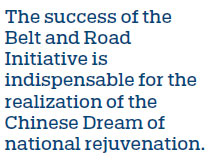Building bridges with neighbors
Without connectivity and cooperation in Northeast Asia, the Belt and Road Initiative will not be complete
The second Belt and Road Forum for International Cooperation in April, 2019, showed the scope of China's involvement and connectivity. Compared to the first forum in 2017, more top leaders attended the second forum and more developed countries supported regional cooperation.
The United States and India did not send their official representatives, but the attendance of some leaders of European Union countries showed the projects are attractive to some developed countries.
Moreover, Italy became the first G7 country to sign up for the Belt and Road Initiative in March. The United Kingdom, too, pledged to strengthen cooperation on the Initiative and support the multilateral trade system in a new round of economic and financial dialogue held in London in June.
As stated at a news conference ahead of the second Belt and Road Forum in 2019 by Chinese foreign minister Wang Yi, the Belt and Road Initiative "is not a geopolitical tool, but a platform for cooperation".
The question is whether the Belt and Road Initiative can be a platform for cooperation in Northeast Asia, and if so, how can the Initiative provide a platform for policy coordination for the region.
Without connectivity and cooperation in Northeast Asia, the Belt and Road Initiative will not be complete. The success or failure of the Initiative will ultimately depend on the progress China makes in its relations with its Northeast Asian neighbors.
If the Initiative is to be a platform for cooperation in Northeast Asia, China should map out an action plan for economic cooperation with countries in the region, including the Republic of Korea and Japan as well as Russia and Mongolia.

It remains to be seen how the Initiative can provide a platform to link Russia's New Oriental Policy, Mongolia's Prairie Road Program, South Korea's New Northern Policy, the proposed East Asia railway community and Japan's development strategies.
One of the most important corridors of Belt and Road Initiative is the China-Mongolia-Russia Economic Corridor, which covers the transportation and tourism sector in Northeast Asia.
It was adopted into the Initiative in 2016. Since then, China, Mongolia and Russia have made efforts to build a cross-border infrastructure connectivity network that includes railways, highways and border ports and they signed a memorandum of understanding to establish a joint promotion mechanism in 2018.
Advancing the China-Mongolia-Russia Economic Corridor will benefit China's Northeast cities such as Harbin and Changchun by attracting investment from the ROK and Japan, as well as domestic investment.
The ROK can take part not only in building infrastructure, but also in making joint efforts with China in logistics, the development of resources and new industries. Such cooperation is beneficial to both parties. ROK-China cooperation is also desirable for the future of Northeast Asia because it would contribute to creating a regional economic development zone.
One good example would be the East Asia railway community building initiative that ROK President Moon Jae-in proposed in August 2018. The initiative for an East Asia railway community has a lot of common ground with the Belt and Road Initiative.
It aims to build an energy and economic community in East Asia and envisions a Northeast Asia multilateral peace and security system. The East Asia railway community would connect the Korean Peninsula with China and Russia. If UN sanctions on the Democratic People's Republic of Korea are lifted, the East Asia railway community could become a reality.
Even if the construction of a Trans-Korea railway cannot be realized due to tensions over the DPRK's development of nuclear weapons, there are other ways for the ROK and China to cooperate.
The ROK, China and Russia can start to build a transport route enabling maritime access to both the ROK and Japan. The Trans-Korean Railway can be linked with Trans-Siberian Railway and Trans-China Railway through the sea route from Sokcho to Zaruvinoor to Hunchun. Japan could join the process because Russia and Japan have been working on plans to link the Japanese railway network with the Trans-Siberian Railway.
Japan has shown a positive change of attitude toward the Belt and Road Initiative and it is now willing to cooperate with China on the Initiative. During their talks ahead of the G20 Summit in Osaka in June, Chinese President Xi Jinping and Japanese Prime Minister Shinzo Abe agreed to build China-Japan relations in accordance with the needs of a new era.
In 2018, Japan had already expressed its interest in cooperating with China in third-party markets, and the Japanese media reported that Japan would cooperate with China by financially supporting private sector partnerships focusing on the environment, industrial modernization and logistics. Given the changing policies and positions of the ROK and Japan on the Belt and Road Initiative, China now has more opportunities to advance the Initiative in Northeast Asia.
The success of the Belt and Road Initiative is indispensable for the realization of the Chinese Dream of national rejuvenation. In order to achieve the goal, it is necessary for China to make every effort to link Chinese northeastern provinces with the Korean Peninsula, laying the foundation for the establishment of a Northeast Asia Economic Zone.
The author is president of the ROK-China Think Net. The author contributed this article to China Watch exclusively. The views expressed do not necessarily reflect those of China Watch. All rights reserved. Copying or sharing of any content for other than personal use is prohibited without prior written permission.

(China Daily Global 08/16/2019 page13)


















